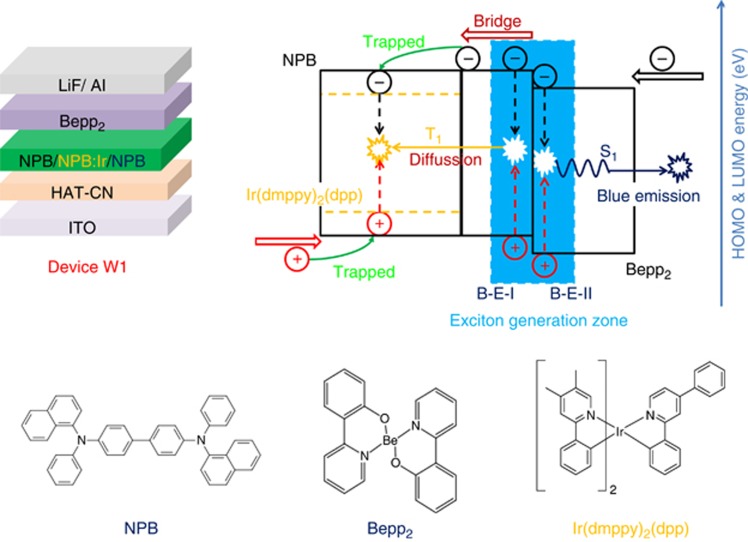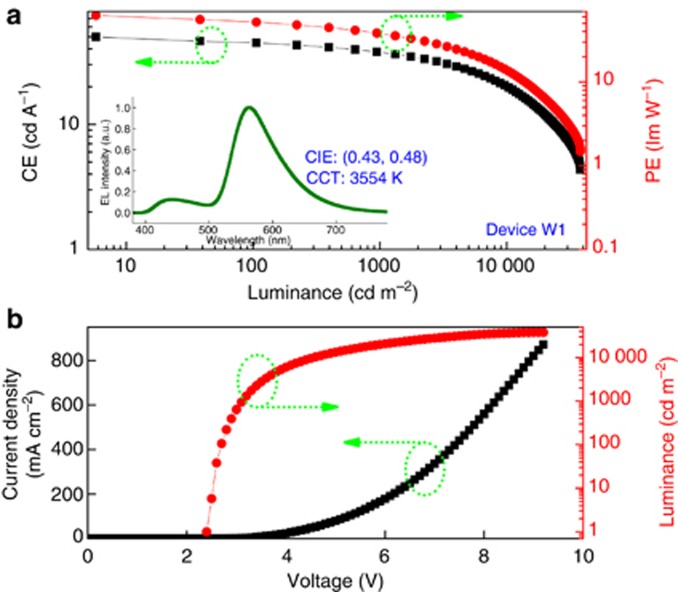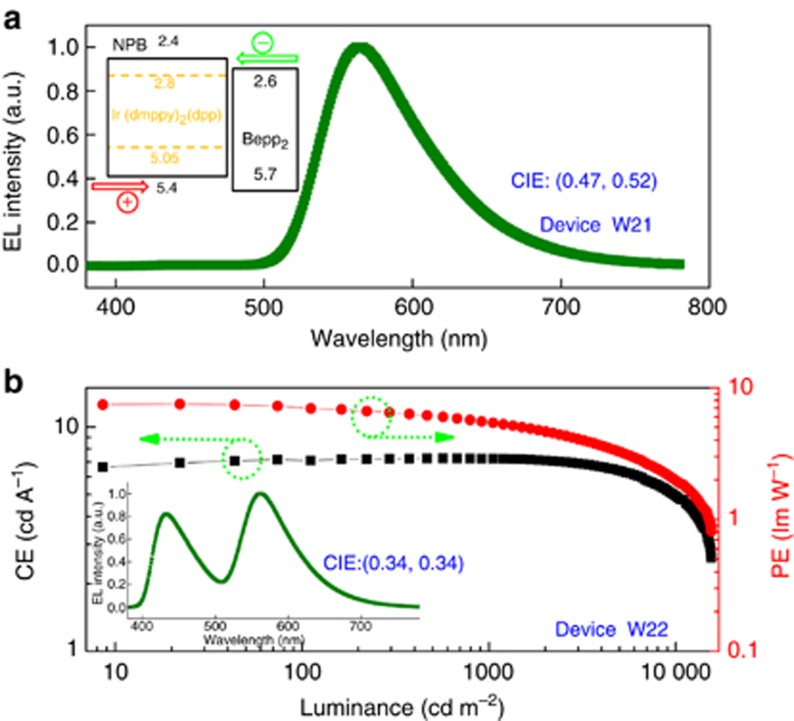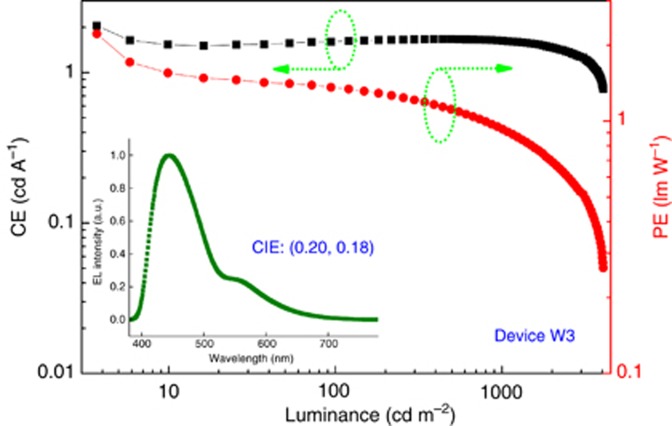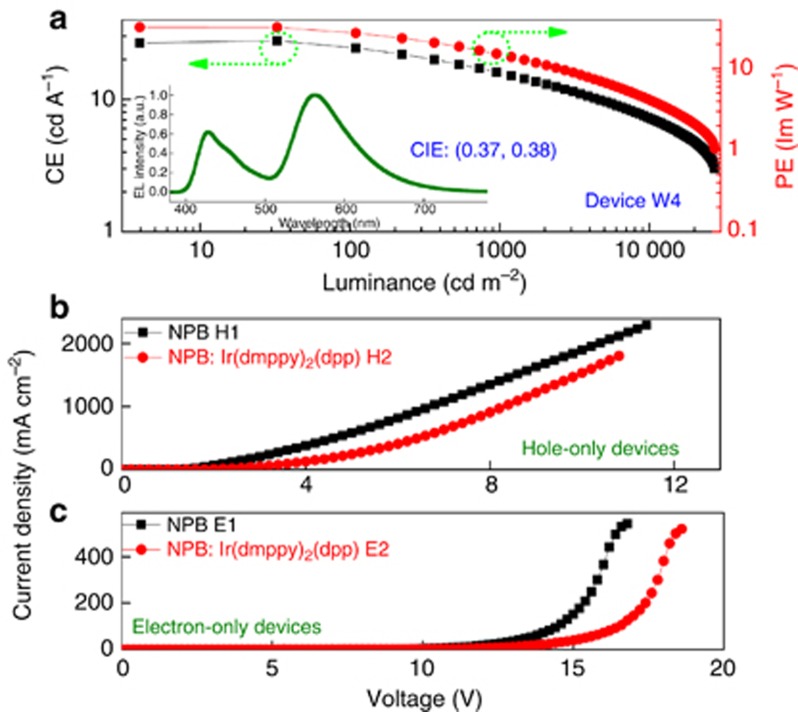Abstract
Numerous hybrid white organic light-emitting diodes (WOLEDs) have recently been developed. However, their efficiency is not comparable to that of their best all-phosphorescent WOLED counterparts, and the structures are usually complicated, restricting their further development. Herein, a novel concept is used to achieve a hybrid WOLED, whose crucial feature is the exploitation of double multifunctional blue emitting layers. The three-organic-layer WOLED exhibits a total efficiency of 89.3 and 65.1 lm W–1 at 100 and 1000 cd m–2, respectively, making it the most efficient hybrid WOLED reported in the literature so far. Significantly, the efficiencies of hybrid WOLEDs have, for the first time, been demonstrated to be comparable to those of the best all-phosphorescent WOLEDs. In addition, the device exhibits the lowest voltages among hybrid WOLEDs (i.e., 2.4, 2.7 and 3.1 V for 1, 100 and 1000 cd m–2, respectively). Such remarkable performance achieved from such an ultrasimplified structure opens a new path toward low-cost commercialization.
Keywords: efficiency, efficiency roll-off, hybrid, structure, white organic light-emitting diodes
Introduction
White organic light-emitting diodes (WOLEDs) have aroused both academic and industrial interest due to their promising applications in displays and lighting1, 2, 3. Compared with all-fluorophor or all-phosphor WOLEDs, hybrid WOLEDs—a term that generally refers to devices utilizing blue fluorescent emitters and orange/green-red phosphorescent emitters—are supposed to be more promising for commercialization owing to their extraordinary characteristics, such as good color stability, excellent lifetime, very-high color rendering index (CRI) as well as high efficiency4, 5, 6, 7, 8, 9, 10, 11, 12, 13, 14, 15, 16, 17, 18, 19, 20. Because all excitons (i.e., singlets and triplets) can be well managed by dint of efficient structures, hybrid WOLEDs with the theoretical 100% internal quantum efficiency can be realized, leading to high efficiency4, 5, 6. In addition, because hybrid WOLEDs avoid using blue phosphors, which are detrimental to color stability, stable colors can be obtained7, 8, 9. Moreover, various blue fluorophors exhibit deep blue colors, making it easy to construct very-high-CRI (⩾90) hybrid WOLEDs10, 11, 12. Finally, there is no perfect blue phosphor in terms of lifetime13, whereas hybrid WOLEDs have been demonstrated to show long lifetimes (>3 × 105 h at 1000 cd m–2) because of the introduction of stable blue fluorophors14.
Forrest et al.4 built a hybrid WOLED by inserting interlayers between fluorescent and phosphorescent emitting layers (EMLs), which can prohibit the unfavorable exciton quenching as well as energy transfer, achieving a maximum forward-viewing power efficiency (PE) of 22.1 lm W–1. Later, Leo et al.15 reported the triplet-harvesting concept to fabricate hybrid WOLEDs, in which blue fluorophors possess high triplet energies. In their device, the interlayer is unnecessary and the fluorescent emitters 4P-NPD (N,N′-di-1-naphthalenyl-N,N′-diphenyl-[1,1′:4′,1′′:4′′,1′′′-quaterphenyl]-4,4′′′-diamine) can fulfill the requirements, attaining a PE of 33.9 lm W–1 at 100 cd m–2. To further simplify the structure, Zhang et al.16 realized a single-EML hybrid WOLED using a fluorescent material as both the host of the orange guest and the sky-blue emitter. With a low-doping guest concentration (0.1%), the generated singlets and triplets in the device were separated to be well harnessed by the host and guest, respectively, achieving the efficiency of 39.5 lm W–1. More recently, Ma et al.17 organized the devcie using 4P-NPD as a blue guest, suppressing the mutual quenching between the fluorophor and phosphors due to the bipolar mixed-host. Thus, the interlayer was averted and a maximum efficiency of 41.7 lm W–1 was recorded. According to the above mentioned findings, the preparation of hybrid structures has been demonstrated to be an effective approach to realize WOLEDs.
From the point of view of real commercialization, structures should be as simplified as possible, which can shorten fabrication procedures, reduce structural heterogeneities, decrease voltages and lower cost. However, the structures of these state-of-the-art hybrid WOLEDs are complicated4, 15, 16, 17. Even for the two-color, single-EML WOLED, four organic layers are needed16. Another drawback of single-EML hybrid WOLEDs is the too low guest concentration (0.1%), making it very hard to the controlling as well as the reproduction of coevaporation procedures18, 19. In addition, the efficiency of these state-of-the-art hybrid WOLEDs is not sufficient. Despite the p-i-n method15 or n-doping technology with an additional electron injection layer17, the maximum efficiency is only ~40 lm W–1, indicating that no hybrid WOLEDs can show comparable efficiencies to their best all-phosphorescent WOLEDs counterparts21, 22, 23, 24, 25, 26, 27. Moreover, the efficiency roll-off problem restricts the evolution of hybrid WOLEDs. For example, although bipolar hosts have been utilized, the PE at 1000 cd m–2 is only 19.7 lm W–1, less than half of the maximum efficiency16. Therefore, effort is needed to alleviate these difficulties.
Herein, we propose a novel concept to organize hybrid WOLEDs. The crucial feature is the exploitation of double multifunctional blue EMLs, which can simplify the structure, guarantee the blue emission, boost the efficiency and reduce the efficiency roll-off. One of the blue EMLs—N,N′-di(naphthalene-1-yl)-N,N′-diphenyl-benzidine (NPB)—functions as a bridge, allowing a portion of electrons to flexibly pass through to reach the orange EML and then form excitons with holes at the orange guest molecules, broadening both the charges and excitons distribution. In addition, the other blue EML—bis[2-(2-hydroxyphenyl)-pyridine] beryllium (Bepp2)—also functions as an electron transporting layer (ETL), reducing the heterojunction between ETL and EML. Using this novel concept, all generated excitons can be effectively harvested.
Materials and Methods
Device structure of the hybrid WOLED
As displayed in Figure 1, the optimized WOLED (W1) has the structure: indium tin oxide (ITO)/1,4,5,8,9,11-hexaazatriphenylene hexacarbonitrile (HAT-CN, 100 nm)/NPB (20 nm)/NPB: bis(2-phenyl-4,5-dimethylpyridinato)[2-(biphenyl-3-yl)pyridinato] iridium(III) [Ir(dmppy)2(dpp), 35 nm, 15%]/NPB (4.5 nm)/Bepp2 (35 nm)/LiF (1 nm)/Al (200 nm), in which ITO acts as the anode, HAT-CN acts as the hole injection layer, Ir(dmppy)2(dpp) acts as the orange phosphor, B-E-I and B-E-II denote the 4.5 nm NPB blue EML and Bepp2 blue EML, respectively. All materials were commercially purchased, and no further purification was performed. Without breaking the vacuum at a base pressure of 2.5 × 10−6 Torr, each layer was thermally deposited. Utilizing correspondingly independent quartz crystal oscillators, both hosts and guests deposition rates were recorded for the doping process. Epoxy glue and glass lids were used to encapsulate the fabricated devices immediately under a nitrogen atmosphere. All emission areas were 3 × 3 mm2. The Commission International de I’Eclairage (CIE) coordinates, electroluminescent (EL) spectra, CRIs and color-correlated temperatures (CCTs) of the prepared WOLEDs were measured via the Konica Minolta CS2000 spectra system (Konica Minolta Company, Osaka, Japan). The current density (J)-voltage-luminance characteristics were measured via the computer-controlled source meter (Keithley 2400, Tektronix Company, Cleveland, OH, USA) as well as multimeter (Keithley 2000) with a calibrated silicon photodiode. The total efficiencies obtained in this work were calculated according to a previously described method4, 15, 16.
Figure 1.
Top: The structure of W1 and schematic diagrams of the working mechanisms. The sky-blue filled region is the main exciton generation zone. Owing to the bridge-like function of B-E-I, a portion of excitons can also be generated at the orange EML via the charge trapping process. Bottom: chemical structures of emitters.
Results and Discussion
As depicted in Figure 2a, W1 possesses the peak forward-viewing current efficiency (CE) of 49.8 cd A–1 and the highest PE of 62.5 lm W–1. Because the total emitted power is typically used to characterize illumination sources4, 15, 16, W1 has the highest total PE of 106.3 lm W–1. At 100 and 1000 cd m–2, the forward-viewing PE are 52.5 and 38.3 lm W–1, corresponding to the total efficiency of 89.3 and 65.1 lm W–1, respectively, indicating that the efficiency at high luminance has already overtaken fluorescent lamps (with typical PE of 40–70 lm W–1). To the best of our knowledge, this is the most efficient hybrid WOLED yet reported in the literature. Even at the display-relevant luminance of 100 cd m–2, the efficiency (52.5 lm W–1) is much higher than the maximum efficiency of state-of-the-art hybrid WOLEDs4, 15, 16, 17, a significant step in hybrid WOLEDs. High efficiencies can be achieved at high luminances, which implies that the efficiency roll-off is greatly reduced4, 15, 16, 17. Significantly, the efficiencies of hybrid WOLEDs, for the first time, have been demonstrated to be comparable to those of best all-phosphorescent WOLEDs20, 21, 22, 23, 24, 25, 26. However, even the best WOLEDs21, 22, 23, 24, 25, 26, 27, 28 are not as simplified as our device, indicating a significant breakthrough in the simplified WOLEDs.
Figure 2.
(a) Forward-viewing CE as well as PE of W1. Inset: the spectrum of W1 (1000 cd m–2). (b) J-voltage-luminance curves.
The CIE coordinates are (0.45, 0.49) and (0.43, 0.48) at 100 and 1000 cd m–2, respectively, and the color-correlated temperatures are 3447 and 3554 K at 100 and 1000 cd m–2, respectively. Similar to previous hybrid WOLEDs, the colors are located within the acceptable warm-white range10, 15, 16, 17, 29. Because of the two-color system, the CRI is not high enough (i.e., 47 at 1000 cd m–2). However, they are still higher than that of sodium lamps (CRI=20) and some two-color WOLEDs5, 18, 19 and are comparable to those of mercury lamps. Because recent works reported that two-color devices with CRI⩾80 can meet the call for high-quality lighting19, 30, we believe that high-efficiency, high-CRI and simplified WOLEDs can be realized if more advanced materials are utilized. Jou et al.31 reported that candle-emission OLEDs with yellowish orange light are more physiologically friendly at night due to the low blue intensity. Clearly, W1 can fulfill this requirement, further demonstrating the advantage of this novel WOLED.
As displayed in Figure 2b, W1 exhibits very low driving voltages. The turn-on voltage is 2.4 V (for 1 cdm–2). The voltages are 2.7 and 3.1 V at 100 and 1000 cd m–2, respectively. To our knowledge, these voltages are the lowest among hybrid WOLEDs4, 5, 6, 7, 8, 9, 10, 11, 12, 13, 14, 15, 16, 17, 18, 19, 20, 32. It can be expected that lower voltage as well as higher efficiency may be obtained if p-i-n structures are utilized15.
To gain insight into the working mechanism of W1, it is necessary to understand the effect of double blue multifunctional EMLs. Because NPB and Bepp2 are p-type and n-type materials, respectively, coupled with the existing energy barriers between these two materials, the main exciton generation zone can be inferred to be located at the B-E-I/B-E-II interface, leading to singlets and triplets (with a ratio of 1:3) being simultaneously generated at the interface5, as shown in Figure 1. Singlets are harvested by NPB and Bepp2, whereas the unused triplets are diffused to the orange region and then harvested by the orange guest because the diffusion lengths of singlets and triplets are ~3 and 100 nm, respectively4. Thus, all generated excitons at the main exciton generation zone are consumed for light. For these emission processes, the triplet energies (T1) of NPB and Bepp2 are 2.3 and 2.6 eV, respectively32, 33, which are higher to meet the call for the emitter Ir(dmppy)2(dpp) (T1<2.25 eV)34, ensuring that triplets can be effectively used. B-E-I confines the majority of electrons injected from the cathode to meet holes at the B-E-I/B-E-II interface, ensuring excitons are mainly generated at this interface; otherwise no blue emission can be furnished. Then, B-E-I functions as a bridge because it can allow the unconfined electrons to flexibly pass through B-E-I to reach the orange EML and then form excitons with holes injected from the anode at the orange guest molecules, resulting in high efficiency and reduced efficiency roll-off. By contrast, B-E-II functions as an ETL because of the high electron mobility of Bepp2 (10−4 cm2/V s)32, which can simplify the structures and reduce the heterojunction between the EML and ETL, enhancing the performance3. Moreover, by dint of double multifunctional blue EMLs, the exciton generation zone is greatly widened, which is beneficial to the high performance8. Apart from the above factors, since the hole mobility and T1 of NPB are high enough33, there is no need to adopt other materials as the hole transport layer (HTL) and host of the orange emitter. Thus, the structure is dramatically simplified (i.e., only three organic layers) and the heterojunctions (between HTL and orange EML or between the orange EML and B-E-I) are eliminated, further enhancing the performance. Therefore, although <25% of the singlets are consumed for the blue emission due to the bridge-like NPB blue EML, all excitons can be harvested via the smart device engineering mentioned above, leading to an extremely high-efficiency hybrid WOLED with ultrasimplified structure.
To further understand the significance of B-E-I, we developed a device (W21) without B-E-I, with the other layers similar to those of W1. For W21, no blue emission was observed, as shown in Figure 3a. Without B-E-I, the main exciton generation zone is located at the orange EML/Bepp2 interface. Because both singlet energy (S1) and T1 of Ir(dmppy)2(dpp) are much lower compared with Bepp2, both singlet and triplet excitons are easily utilized by this orange emitter, leading to only orange emission3.
Figure 3.
(a) the EL spectrum of W21 (1000 cd m–2). (b) CE and PE for W22. Inset: the EL spectrum of W22 (1000 cd m–2).
NPB and Bepp2 exhibit similar peak emissions (~440 nm) due to the similar S132, 33, which indicates that the blue emission is produced by them. To prove that the blue emission originates from B-E-I and to illustrate the significance of Bepp2 functioning as the B-E-II/ETL, we developed a device (W22) by replacing Bepp2 with 35 nm 2,2′,2″-(1,3,5-benzinetriyl)-tris(1-phenyl-1-H-benzimidazole) (TPBi); the other layers were similar to those of W1. TPBi is a well-known electron transport material with a high T1 (2.74 eV) and almost the same electron mobility as Bepp2, whose lowest unoccupied molecular orbital (LUMO) and highest occupied molecular orbital (HOMO) are 2.7 and 6.2 eV, respectively35. By using TPBi, the blue emission originating from Bepp2 was excluded. As expected, white emission was still achieved by combining the blue emission from NPB (~440 nm) with the orange emission from Ir(dmppy)2(dpp), as shown in Figure 3b (inset). However, the maximum PE is only 7.5 lm W–1, which is 8.3 times lower than that of W1, indicating the significance of Bepp2, as shown in Figure 3b.
To prove that Bepp2 contributes blue emission in W1, we developed a device (W3) by replacing B-E-I with 4.5 nm 1-bis[4-[N,N-di(4-tolyl)amino]phenyl]-cyclohexane (TAPC) to exclude the NPB emission; the other layers were similar to those of W1. Because TAPC is a typical p-type material with a T1 of 2.9 eV and a hole mobility of 10−2 cm2 V–1 s whose LUMO and HOMO are 1.8 and 5.3 eV, respectively32, the exciton generation zone is located at the TPAC/Bepp2 interface. For device W3, it is difficult for electrons to pass through TAPC due to the large LUMO barrier between TAPC and Bepp2 (0.8 eV) as well as the negligible electron mobility of TAPC, and it is difficult for triplets to diffuse to the orange EML due to the high T1 31. Therefore, TAPC acts as an electron- and exciton-blocking layer, which can be used to observe the Bepp2 emission. As expected, no white emission was observed, because only blue emission (~440 nm) originating from Bepp2 and very weak orange emission were produced, as shown in Figure 4 (inset). Because most triplets decay nonradiatively and singlets are harvested only by Bepp2, the maximum efficiency of W3 is only 2.2 lm W–1, as shown in Figure 4. These results also demonstrate the importance of B-E-I.
Figure 4.
Forward-viewing CE and PE for W3. Inset: the EL spectrum (1000 cd m–2).
Finally, to illustrate the bridge-like function of B-E-I, we developed a device (W4) by replacing B-E-I with 4.5 nm 4P-NPD; the other layers were similar to those of W1. Because 4P-NPD exhibits blue emission, high hole mobility and high T1 (2.3 eV), the exciton generation zone is located at the 4P-NPD/Bepp2 interface5. Thus, double blue EMLs are also formed in W4. However, the electron mobility of 4P-NPD is negligible, indicating that it is difficult for electrons to pass through the 4.5 nm 4P-NPD layer to reach the orange region5. Therefore, 4P-NPD cannot function as a bridge. Compared with 4P-NPD, NPB exhibits somewhat bipolar characteristics because it can even be an ETL36. This bipolar characteristic makes NPB act as a bridge, rendering it possible for electrons to pass through B-E-I to reach the orange EML. Then, Ir(dmppy)2(dpp) can effectively trap these electrons because NPB (2.4 V)33 possesses a much higher LUMO than Ir(dmppy)2(dpp) (2.8 eV)34. Moreover, holes can be effectively trapped by Ir(dmppy)2(dpp) because NPB (5.4 eV)33 possesses a lower HOMO than Ir(dmppy)2(dpp) (5.05 eV)34. Therefore, as shown in Figure 1, the direct exciton formation can also produce the orange emission in the host-guest system [NPB-Ir(dmppy)2(dpp)]. This emission mechanism can effectively boost efficiency because there is no need to excite the host and the charge leakage is decreased3. Furthermore, the charge trapping procedure can reduce efficiency roll-off because trapped charges do not suffer the diffusive transport loss, and the reduced charge/exciton accumulation at the EML edges decreases the triplet-triplet annihilation and triplet-polaron quenching12. Thus, both the charges and excitons distribution are effectively broadened by the bridge-like function of B-E-I, enhancing the performance.
To clarify the above analyses, we measured the performance of W4, as shown in Figure 5a. W4 shows the peak efficiency of 32.3 lm W–1 as well as 15.0 lm W–1 at 1000 cd m–2, which are 93.5% and 152.3% lower than those of W1, respectively. The performances indicate that W4 exhibits a much more serious efficiency roll-off than W1, demonstrating the importance of the bridge-like function of B-E-I. For device W4, because all electrons are confined at the 4P-NPD/Bepp2 interface, a strong exciton density is formed at this interface, which is detrimental to the efficiency and efficiency roll-off3. Therefore, although 4P-NPD has a high photoluminescence quantum efficiency of 92%5, W4 exhibits an unsatisfactory performance.
Figure 5.
(a) CE as well as PE for W4. Inset: the spectrum of W4 (1000 cd m–2). (b) J-voltage characteristic for hole-only devices. (c) J-voltage characteristic for electron-only devices.
To illustrate the charge trapping process in the NPB-Ir(dmppy)2(dpp) system, we have developed hole-only as well as electron-only devices comprising configurations of ITO/HAT-CN (100 nm)/NPB (20 nm)/NPB: guest (35 nm)/NPB (20 nm)/Al (200 nm) and ITO/LiF (1 nm)/Bepp2 (50 nm)/NPB: guest (35 nm)/NPB (4.5 nm)/Bepp2 (35 nm)/LiF (1 nm)/Al (200 nm), respectively, in which guest signifies nothing for devices H1 and E1 and 15% Ir(dmppy)2(dpp) for devices H2 and E2. As displayed in Figure 5b, because of the hole trapping effect of Ir(dmppy)2(dpp), it is reasonable that the J of H2 is much lower than that of H1. In addition, as displayed in Figure 5c, the J of E2 is lower than that of E1 because of the electron trapping effect of Ir(dmppy)2(dpp). Thus, the main exciton generation and emission mechanism in the NPB-Ir(dmppy)2(dpp) system is the direct charge trapping on this guest3. In other words, orange emission is obtained from the combined mechanisms of triplets diffusion and direct exciton formation on Ir(dmppy)2(dpp).
Then, to further demonstrate the importance of the novel concept, even higher efficiency can be expected because the photoluminescence efficiency (q) of blue emitters is not high enough37, and p-i-n methods or outcoupling technologies have not been adopted in this work12, 22. Supposing the Lambertian type is the emission pattern, a connection of the external quantum efficiency (ηext) and PE can be described as:3
where U is the operational voltage. ηext can be described as:
where ηout, r and γ represent a outcoupling factor, a ratio of excitons which potentially decay radiatively and a charge balance, respectively. As a result, PE can be described as:
To further boost the efficiency, U should be low while ηout, r, q and γ high. Hence, much higher efficiency can be expected if more advanced blue emitters can be obtained. Besides, the efficiency can be improved if p-i-n methods or outcoupling technologies are used12, 22.
Conclusions
In conclusion, by smartly exploiting double multifunctional blue EMLs, the novel three-organic-layer device shows the highest efficiencies and lowest voltages among hybrid WOLEDs, despite not using p-i-n technology. Previously, hybrid WOLEDs have demonstrated stable colors, very-high CRIs and long lifetimes. Here, we have demonstrated that extremely high efficiency and low voltage can be achieved via ultrasimplified structures. The efficiencies of the hybrid WOLEDs have, for the first time, been demonstrated to be comparable to those of the best all-phosphorescent WOLEDs. Remarkably, the structure is the most simplified among the best WOLEDs, indicating a significant breakthrough in the simplified WOLEDs. Such exceptionally high performance is obtained via an ultrasimplified structure, which opens a new path toward the low-cost commercialization of WOLEDs in the display and lighting markets.
Acknowledgments
This work was supported by the National ‘973’ Project of China (Grant No. 2015CB655000), the National Natural Science Foundation of China (Grant Nos. 61401156 and U1301243), the Guangdong Innovative Research Team Program (Grant No. 201101C0105067115), the Educational Commission of Guangdong Province (Grant Nos. 2014KZDXM010 and 2014GKXM012), the National Laboratory for Infrared Physics Open Project (Grant No. M201406), the Natural Science Foundation of Guangdong Province (Grant No. 2014A030310253) and the Guangzhou Science and Technology Plan (Grant No. 2013Y2-00114).
Footnotes
The authors declare no conflict of interest.
References
- Sasabe H, Kido J. Development of high performance OLEDs for general lighting. J Mater Chem C 2013; 1: 1699–1707. [Google Scholar]
- Kamtekar KT, Monkman AP, Bryce MR. Recent advances in white organic light-emitting materials and devices (WOLEDs). Adv Mater 2010; 22: 572–582. [DOI] [PubMed] [Google Scholar]
- Wang Q, Ma DG. Management of charges and excitons for high-performance white organic light-emitting diodes. Chem Soc Rev 2010; 39: 2387–2398. [DOI] [PubMed] [Google Scholar]
- Sun YR, Giebink NC, Kanno H, Ma BW, Thompson ME et al. Management of singlet and triplet excitons for efficient white organic light-emitting devices. Nature 2006; 440: 908–912. [DOI] [PubMed] [Google Scholar]
- Schwartz G, Reineke S, Rosenow TC, Walzer K, Leo K. Triplet harvesting in hybrid white organic light-Emitting diodes. Adv Funct Mater 2009; 19: 1319–1333. [Google Scholar]
- Chen JS, Zhao FC, Ma DG. Hybrid white OLEDs with fluorophors and phosphors. Mater Today 2014; 17: 175–183. [Google Scholar]
- Yook KS, Jeon SO, Lee JY, Lee KH, Kwon YS et al. High efficiency pure white organic light-emitting diodes using a diphenylaminofluorene-based blue fluorescent material. Org Electron 2009; 10: 1378–1381. [Google Scholar]
- Zhao FC, Zhang ZQ, Liu YP, Dai YF, Chen JS et al. A hybrid white organic light-emitting diode with stable color and reduced efficiency roll-off by using a bipolar charge carrier switch. Org Electron 2012; 13: 1049–1055. [Google Scholar]
- Zhang DD, Duan L, Li YL, Zhang DQ, Qiu Y. Highly efficient and color-stable hybrid warm white organic light-emitting diodes using a blue material with thermally activated delayed fluorescence. J Mater Chem C 2014; 2: 8191–8197. [Google Scholar]
- Jou JH, Chou YC, Shen SM, Wu MH, Wu PS et al. High-efficiency, very-high color rendering white organic light-emitting diode with a high triplet interlayer. J Mater Chem 2011; 21: 18523–18526. [Google Scholar]
- Chen SM, Tan GP, Wong WY, Kwok HS. White organic light-emitting diodes with evenly separated red, green, and blue colors for efficiency/color-rendition trade-off optimization. Adv Funct Mater 2011; 21: 3785–3793. [Google Scholar]
- Sun N, Zhao YB, Zhao FC, Chen YH, Yang DZ et al. A white organic light-emitting diode with ultra-high color rendering index, high efficiency, and extremely low efficiency roll-off. Appl Phys Lett 2014; 105: 013303. [Google Scholar]
- Zhang YF, Lee J, Forrest SR. Tenfold increase in the lifetime of blue phosphorescent organic light-emitting diodes. Nat Commun 2014; 5: 5008. [DOI] [PubMed] [Google Scholar]
- Liu BQ, Wang L, Xu M, Tao H, Zou JH et al. Efficient hybrid white organic light-emitting diodes with extremely long lifetime: the effect of n-type interlayer. Sci Rep 2014; 4: 7198. [DOI] [PMC free article] [PubMed] [Google Scholar]
- Schwartz G, Pfeiffer M, Reineke S, Walzer K, Leo K. Harvesting triplet excitons from fluorescent blue emitters in white organic light-emitting diodes. Adv Mater 2007; 19: 3672–3676. [Google Scholar]
- Ye J, Zheng CJ, Ou XM, Zhang XH, Fung MK et al. Management of singlet and triplet excitons in a single emission layer: a simple approach for a high-efficiency fluorescence/phosphorescence hybrid white organic light-emitting device. Adv Mater 2012; 24: 3410–3414. [DOI] [PubMed] [Google Scholar]
- Sun S, Wang Q, Zhao YB, Chen YH, Yang DZ et al. High-performance hybrid white organic light-emitting devices without interlayer between fluorescent and phosphorescent emissive regions. Adv Mater 2014; 26: 1617–1621. [DOI] [PubMed] [Google Scholar]
- Hofmann S, Furno M, Lüssem B, Leo K, Gather MC. Investigation of triplet harvesting and outcoupling efficiency in highly efficient two-color hybrid white organic light-emitting diodes. Phys Status Solidi A 2013; 210: 1467–1475. [Google Scholar]
- Liu BQ, Xu M, Wang L, Zou JH, Tao H et al. Regulating charges and excitons in simplified hybrid white organic light-emitting diodes: the key role of concentration in single dopant host–guest systems. Org Electron 2014; 15: 2616–2623. [Google Scholar]
- Peng T, Yang Y, Bi H, Liu Y, Hou ZM et al. Highly efficient white organic electroluminescence device based on a phosphorescent orange material doped in a blue host emitter. J Mater Chem 2011; 21: 3551–3553. [Google Scholar]
- Su SJ, Gonmori E, Sasasbe H, Kido J. Highly efficient organic blue-and white-light-emitting devices having a carrier- and exciton-confining structure for reduced efficiency roll-off. Adv Mater 2008; 20: 4189–4194. [Google Scholar]
- Reineke S, Lindner F, Schwartz G, Seidler N, Walzer K et al. White organic light-emitting diodes with fluorescent tube efficiency. Nature 2009; 459: 234–238. [DOI] [PubMed] [Google Scholar]
- Sasabe H, Takamatsu JI, Motoyama T, Watanabe S, Wagenblast G et al. High-efficiency blue and white organic light-emitting devices incorporating a blue iridium carbene complex. Adv Mater 2010; 22: 5003–5007. [DOI] [PubMed] [Google Scholar]
- Lee J, Chopra N, Bera D, Maslov S, Eom SH et al. Down-conversion white organic light-emitting diodes using microcavity structure. Adv Energy Mater 2011; 1: 174–178. [Google Scholar]
- Li N, Oida S, Tulevski GS, Han SJ, Hannon JB et al. Efficient and bright organic light-emitting diodes on single-layer graphene electrodes. Nat Commun 2013; 4: 2294. [DOI] [PubMed] [Google Scholar]
- Ou QD, Zhou L, Li YQ, Shen S, Chen JD et al. Extremely efficient white organic light-emitting diodes for general lighting. Adv Funct Mater 2014; 24: 7249–7256. [Google Scholar]
- Lee S, Shin H, Kim JJ. High-efficiency orange and tandem white organic light-emitting diodes using phosphorescent dyes with horizontally oriented emitting dipoles. Adv Mater 2014; 26: 5864–5868. [DOI] [PubMed] [Google Scholar]
- Higuchi T, Nakanotani H, Adachi C. High-efficiency white organic light-emitting diodes based on a blue thermally activated delayed fluorescent emitter combined with green and red fluorescent emitters. Adv Mater 2015; 27: 2019–2023. [DOI] [PubMed] [Google Scholar]
- Bhansali US, Jia HP, Oswald IWH, Omary MA, Gnade BE. High efficiency warm-white organic light emitting diodes from a single emitter in graded-doping device architecture. Appl Phys Lett 2012; 100: 183305. [Google Scholar]
- Chang CH, Chen CC, Wu CC, Chang SY, Hung JY et al. High-color-rendering pure-white phosphorescent organic light-emitting devices employing only two complementary colors. Org Electron 2010; 11: 266–272. [Google Scholar]
- Jou JH, Hsieh CY, Tseng JR, Peng SH, Jou YC et al. Candle light-style organic light-emitting diodes. Adv Funct Mater 2013; 23: 2750–2757. [Google Scholar]
- Chen YH, Zhao FC, Zhao YB, Chen JS, Ma DG. Ultra-simple hybrid white organic light-emitting diodes with high efficiency and CRI trade-off: fabrication and emission-mechanism analysis. Org Electron 2012; 13: 2807–2815. [Google Scholar]
- Liu SW, Divayana Y, Abiyasa AP, Tan ST, Demir HV et al. On the triplet distribution and its effect on an improved phosphorescent organic light-emitting diode. Appl Phys Lett 2012; 101: 093301. [Google Scholar]
- Liu BQ, Wang L, Xu M, Tao H, Gao DY et al. Extremely stable-color flexible white organic light-emitting diodes with efficiency exceeding 100 lm W−1. J Mater Chem C 2014; 2: 9836–9841. [Google Scholar]
- Gao CH, Zhou DY, Gu W, Shi XB, Wang ZK et al. Enhancement of electroluminescence efficiency and stability in phosphorescent organic light-emitting diodes with double exciton-blocking layers. Org Electron 2013; 14: 1177–1182. [Google Scholar]
- Tse SC, Kwok KC, So SK. Electron transport in naphthylamine-based organic compounds. Appl Phys Lett 2006; 89: 262102. [Google Scholar]
- Fukagawa H, Shimizu T, Kamada T, Kiribayashi Y, Osada Y et al. Highly efficient and stable phosphorescent organic light-emitting diodes utilizing reverse intersystem crossing of the host material. Adv Optical Mater 2014; 2: 1070–1075. [Google Scholar]



